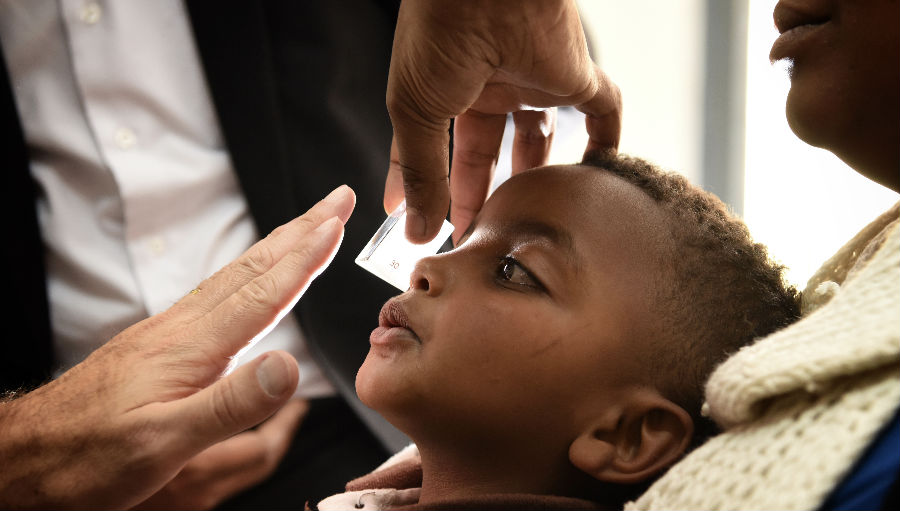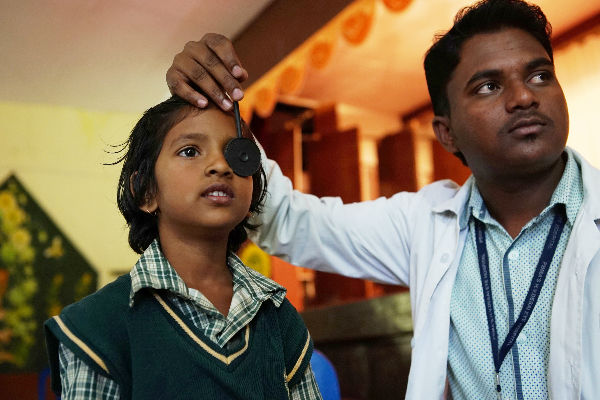Join a powerful, unprecedented alliance for better eye health for all.
Join IAPB-
Choose an alternate language here
On Universal Children’s Day, Nathan Congdon on Orbis saving vision and changing children’s lives across the world.
 The pyramid of children’s vision
The pyramid of children’s visionOrbis has been working to change lives through the prevention and treatment of avoidable blindness since 1982. A large focus of this work has been treating cases of childhood blindness. The numerous conditions that affect childhood eye health can be viewed as fitting into a pyramid, with the rarest and most difficult-to-treat problems at the top, and common and easier-to-manage conditions at the bottom. Orbis is unique in that our programmes reach out to children and communities affected by eye conditions at all levels of this pyramid.

Among the most serious children’s vision problems is retinopathy of prematurity (ROP). ROP occurs when blood vessels at the periphery of a premature child’s eye fail to develop properly, leading them to secrete growth chemicals which damage the eye. Systemic treatments given to these children, if not properly administered, can further damage the eye. Orbis’ has worked to expand its’ expertise on ROP through exchanging skills. This exchange includes: training teams to deliver oxygen at safe levels, explaining to families the need for regular eye exams, and developing a local cadre of expert ophthalmologists to safely deliver sight-saving treatment. This combination of prevention and treatment greatly reduces risk of vision loss from ROP, which is among the most common problems found across schools for the blind.
Further down the pyramid are pediatric versions of two common adult-blinding diseases, cataract and glaucoma. Both eye conditions are much rarer in children, but the challenge presented is acute; a temporary blockage to vision in one eye can lead to amblyopia, or “lazy eye”. Children with these rare vision conditions must be identified and treated early in life and families educated to understand that delays in care can lead to permanent vision loss. Orbis has worked to train local teams, from eye surgeons to anesthesiologists, on these corrective surgeries.
Even more common is the condition known as “squint” or strabismus, where the eyes of a child fail to work together when one turns inward or outward. Strabismus can be managed with glasses or surgery to straighten the eye. This condition is sometimes classified by government insurance as cosmetic work. However, our research has shown that children with uncorrected strabismus are more likely to have depression and anxiety, due to social and educational disruptions. Our programmes around the world have not only treated thousands children, but have also successfully changed government policies.
As Director of Research at Orbis, my own work has focused for many years on the bottom of the pyramid, the most common and treatable children’s vision problem: refractive error. Though glasses provide cheap and safe treatment, lack of knowledge and poor access to high-quality care means that some 13 million children globally are needlessly visually impaired. As few as 20% of children needing glasses have them in the countries where we work. Orbis programmes such as REACH (Refractive Error Among Children) in India are making a huge contribution to shifting the dial on refractive error, with three million children screened in India alone. We are also delivering refractive care to Rohingya children in refugee camps in Bangladesh, improving the resiliency of these displaced communities.

Still, the global number of children affected by nearsightedness (myopia) is rising rapidly, due to educational pressure and lack of time outdoors, especially in countries such as China. Research sponsored by Orbis, showed that a single pair of glasses can significantly improve a child’s educational prospects. Orbis programmes have not only led to the delivery of hundreds of thousands of glasses worldwide, but they have also helped to catalyze the adoption of national myopia control programmes in countries such as China.
Orbis is unique in its ability to deliver child-centered programmes through multiple points of intervention: from the intensive care unit, to the school, and to the community. Although the pyramid of children’s eye problems is complicated, nearly 60% of these conditions are treatable. All of those treatments have the potential to change a child’s life by restoring sight and improving access to education and the lifetime of opportunities it confers.
Image on top: A child being examined onboard the Orbis Flying Hospital/Photo credit: Geoff Oliver Bugbee
Photo submitted by Keith Kalu, to the IAPB World Sight Day Photo Competition.